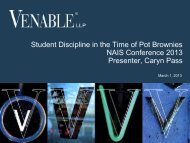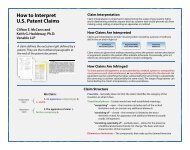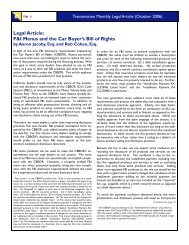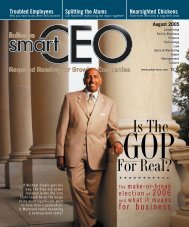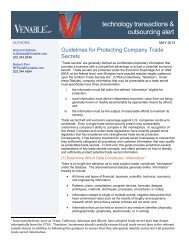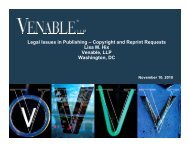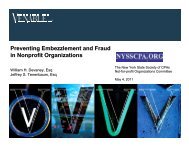The New IRS Form 990: What Does It Mean For Your ... - Venable LLP
The New IRS Form 990: What Does It Mean For Your ... - Venable LLP
The New IRS Form 990: What Does It Mean For Your ... - Venable LLP
Create successful ePaper yourself
Turn your PDF publications into a flip-book with our unique Google optimized e-Paper software.
are now required to report the five highest employee salaries. <strong>The</strong> threshold for that reporting requirement has<br />
been raised from $50,000 to $100,000. When accounting for executive compensation, filers will now use <strong><strong>For</strong>m</strong> W-<br />
2 and <strong><strong>For</strong>m</strong> 1099 information as a starting point, but must also provide an estimate of nontaxable fringe benefits<br />
(such as retirement plan contributions and health and welfare benefits) in order to allow for a more complete<br />
picture of the compensation package. See the “Executive Compensation” section below for more on the reporting<br />
of executive compensation in Schedule J.<br />
One of the most popular and least complicated additions to the 2008 form is Part IV, “Checklist of Required<br />
Schedules,” designed to provide the <strong>IRS</strong> with a broad overview of an organization’s activities and to assist<br />
organizations with completing the proper sections. By answering this series of questions, a tax-exempt<br />
organization verifies which of the 16 <strong><strong>For</strong>m</strong> <strong>990</strong> schedules it is required to submit. <strong>The</strong> <strong>IRS</strong> has revised many of<br />
the old schedules and added new schedules to the list. <strong>The</strong> total effect will require organizations to track and<br />
disclose certain information with much more detail than in the past.<br />
Public Charity Status and Public Support. Prior to the release of the 2008 form, Schedule A — which must be<br />
completed by all 501(c)(3) public charities — required information regarding numerous topics unrelated to the<br />
basis of the organization’s public charity status, such as information about lobbying activities and transactions<br />
with non-charitable tax-exempt organizations. <strong>The</strong> redesigned Schedule A now focuses exclusively on public<br />
charity status; the questions on unrelated topics have been moved to other schedules. In addition, the public<br />
support test testing period has been increased from four to five years (to simplify the process and allow for the<br />
eventual elimination of the advance ruling process), the public support test for 509(a)(1) organizations has been<br />
separated from the support test for 509(a)(2) organizations, and space has been added for a narrative<br />
explanation to justify the “10% facts and circumstances” test, if applicable.<br />
Political Campaign and Lobbying Activities. Since <strong><strong>For</strong>m</strong> <strong>990</strong> was first drafted nearly thirty years ago, taxexempt<br />
organizations have grown more and more adept at participation in lobbying and political activities. <strong>The</strong><br />
redesigned form incorporates expanded questions about lobbying and political expenditures and activities into a<br />
new Schedule C. Of note, the <strong>IRS</strong> has added questions regarding the transfer of funds between tax-exempt<br />
organizations and so-called “527 organizations,” and non-501(c)(3) tax-exempt entities will now be required to<br />
provide more extensive reporting of lobbying and political campaign activities.<br />
Statement of Activities Outside of the United States. In order to provide a more complete picture of an<br />
organization’s international activities, Schedule F now requests information about tax-exempt organizations that<br />
raise funds, make grants, or conduct trade, business or other activities outside of the United States.<br />
Organizations with more than $10,000 of aggregate expenses or revenues from foreign activities will be required<br />
to describe their operations on a region-by-region basis, and to provide information regarding grants or assistance<br />
made to foreign governments, organizations and individuals. <strong>The</strong>se reporting requirements are expected to result<br />
in new recordkeeping practices for entities with substantial overseas activities.<br />
Executive Compensation. Nonprofit officers, directors and employees who earn more than $150,000 in<br />
reportable compensation (as reflected on <strong><strong>For</strong>m</strong>s W-2 or 1099) or $250,000 in total compensation (including<br />
nontaxable fringe benefits and expense reimbursements) will trigger more detailed reporting requirements in a<br />
redesigned Schedule J, including breaking out base compensation, bonus and incentive compensation, other<br />
compensation, deferred compensation, certain nontaxable benefits (described below), and compensation reported<br />
in prior <strong><strong>For</strong>m</strong>s <strong>990</strong>. While the final version of Schedule J eliminates the reporting of de minimis fringe benefit and<br />
nontaxable expense arrangement/reimbursement amounts that had been included in the draft, certain<br />
arrangements that may raise “tax compliance and transparency concerns” must now be reported, including<br />
payments for first-class or charter travel, travel for companions, tax indemnification and gross-up payments,<br />
discretionary spending accounts, housing allowances and payments for the business use of a personal residence,<br />
health or social club dues or fees, and personal services (such as those of a maid, chauffeur or chef).<br />
<strong>The</strong> double counting of deferred compensation — requiring deferred compensation to be reported both in the year





